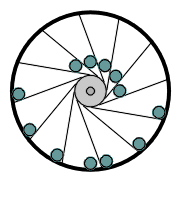
A sensible discussion of the machines from the 16th to 18th century must not be based on today's knowledge of science and technology. We have to consider that at those times there was a great revolution of ideas which still has effect today. But the influence of older concepts of alchemy, astrology etc. was still strong and decreased slowly. Many things which are regarded as ridiculous today, seemed plausible. And many ideas which were considered to be forever out of man's reach now are an everyday's experience like the flight by the aid of machines.
This was the soil, into which the seed of perpetual machines fell and sometimes grew to considerable frauds. A judgement of the situation gives Zedler's Universallexikon (1756), cited in the Propyläen Technikgeschichte: "Such project makers dare contacting high persons, and a minister has to apply all care to explore if his sovereign is into business with an honorable man or a fraud..."1) (vol. 3, p 256).
William Sommerset, Marquis of Worcester (1612-1667), was one of the prominent persons at his time. 1638 he suggested to his king, Charles I, the construction of a gigantic perpetual motion machine. It consisted of a wheel of around 4m diameter. At the periphery, it had 40 chambers, each containing an unbalanced mass of 50 pounds. The device was presented to king and court, and Sir William concluded chapter 56 of his book Century of Inventions2): "be pleased to judge the consequences", leaving the important detail open if he simply wanted to keep his reader busy with analysing the machine.
 |
Johann Jacob Leupold (22. June 1674 - 12. Jan. 1727) analysed a similar apparatus in his encyclopaedic work Theatrum mechanicum machinarum and came to the conclusion: "with one pound one can keep one pound in equilibrum, but never move it." About Leupold and his main opus, Theatrum Machinarum the library of the Deutsches Museum in Munich has provided a large text on their site.
 |
This gentleman is Johann Ernst Elias Bessler (1680-1745). With his artist's name Orffyreus he made carreer and wrote a chapter in the history of technology. Bessler was an universally skilled, but unsteady man who rarely kept continuing a work for a longer period of of time, thus frequently lacking money. But Bessler was intelligent, learned quickly and he was an eloquent speaker. So he understood quite well to get his advantages out of every situation. At a time, when German rulers used to employ court's mechanicians and alchemists (often with the intention to fill their own purse), Bessler attracted attention in 1715 as he presented an apparently working perpetual motion machine to the public. In 1716, Landgrave Karl of Hessen-Kassel got interested in the machine, and the German mathematician and philosopher Leibniz recommended to invite Bessler, who followed the invitation. Landgrave Karl provided a large room in his Weissenstein castle where Bessler built a larger sample of his machine and set it into motion. The room was closed and the doors sealed. As it was re-opened after a fourty-day period, the machine still kept running at unchanged speed. |
Even czar Peter the great developed vivid interest in Bessler's perpetual motion machine and planned to travel to Germany in 1725 in order to have a look at the apparatus and maybe to buy it. The czar commanded a scientific check and purchasing negociations. Orffyreus demanded the unheard amount of 100000 talers for his machine. The czar's untimely death runined the sale.
A clearer impression of the machine give a few woodcuts Bessler published in his book Perpetuum mobile triumphans (Kassel 1719). How the device worked cannot be concluded from the illustrations.
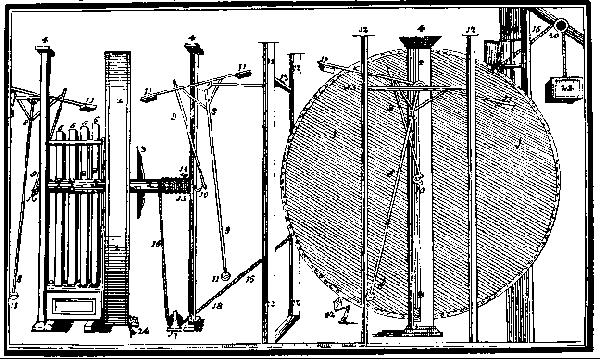
Meanwhile, Bessler-Orffyreus was being named councillor by Landgrave Karl and enjoyed his fame to be the only inventor of a real perpetual motion machine.
In all the years of the machine's existence, there were followers and opponents of Orffyreus' apparatus. Leibniz not being convinced of the perpetual motion idea gave the remark "Qrffyreus est des mes amis" ("Orffyreus is amongst my friends" Klemm, S.16). Other scholars thought the inventor should be rewarded in order to get a glance into the inner mechanism of the machine. And there were others who regarded the whole story as a gigantic fraud. Bessler allowed only the landgrave to peep into the machine and he testified that it was a real perpetual motion machine. Today, the engineering skills of souvereigns are rather regarded as being elementary.
The story ended with the confession of a maid who kept the machine turnig from the adjacent room. She worked in shifts with Bessler's wife and brother being poorly paid with 2 pennies per hour. In a nutshell: Bessler was a fraud. At the begin of the 18th century, there used to be rarely mercy with frauds who duped their souvereigns, which is easily seen at the example of Cajetano the gold-maker, who in 1709 was "raised" - at the gallows.
But the surprise happend. By eloquence and clever arguing, Besser escaped the landgrave's rage and even succeeded in keeping his good will. When the landgrave died, Bessler lost friendship and shelter, but not his life. The legend reports that Bessler destroyed his work with his own hands.
Revealing is the web of reports and expert evidence, of machines analysises and distrust. There were plots and attemps to discredit the inventor, as well as opinions to support his work. 's Gravesande, who was a good researcher, stated Bessler's wheel to be a true perpetual motion machine. After the fraud was uncovered, he had hard work to rescue his reputation and argued "I know well that Orffyreus is a crackpot, but I don't believe he is a fraud. I have never decided that his machine is fraud, but I know one thing for sure: if the maid sais this, she is a liar."3) (translated from Michal, p.111)
Leibniz, smart enough to keep away from the whole events, suggested to learn from the mechanisn. He refused the proof of a real PMM. Survived have several reports which state that the wheel moved without visible external energy source, the maid's written oath (cf. Michal, p.110) and the knowledge that Bessler took the secret of his machines into the grave. A useful internet information resouce is the site http://www.besslerwheel.com.
There seems no final conclusion. The end of the whole story still is open and the discussion around Bessler is still ongoing. A simple internet research with one of the large search engines delivers thousands of references which are connected in some way to Bessler. Around 30 of them show reasonable effort to approach his work and publishings. Most authors state Bessler has been victim of the circumstances, having been inventor of a real perpetual motion machine. The maid of course had brought her employer into bad reputation by lies. I ask the readers to draw their own conclusions; some references can be found in my linklist.
Hundred years after Bessler's death, a very skillfully made perpetual clock attracted the the attention. At la Chaux-de-Fonds in Switzerland, a travelling clockmaker named David Robert Geiser (-1817)4) presented a clockwork that he claimed to be a real perpetual device. It seemed to be powered by an arabian wheel of 11/2ft diameter, that had 39 arms at its rim, each containing a complex trigger mechanism. The clock was disassembled and inspected several times by specialists, but none of them found any concealed source of power. So eventually, somebody really had succeeded in building a PMM?
After Geiser's early death, the clockwork was inspected again. This time, a very careful analysis revealed the fraud. In one of the columns that supported the dial, the examiners found a hidden shaft leading to a spring in the base of the clock. The spring could be wound by detaching the seconds hand. After removing the hand, a four-cournered axle got accessible which onto wich a wind-key fitted. In fact, the clock was an outstanding masterpiece - but no perpetual motion machine.
In 1870, Charles Batchellor got a machine patented which was made up of cog-wheels, levers and excentric weights. It's remarkable that he got a patent at all, but sometimes absurd constructions slip through the patent examiners' attention. I mention this apparatus because it contains all major construction features of the devices given by Würth and Evert. So even "modern" ideas had their predecessors 130 years ago.
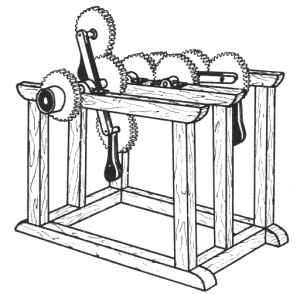
|
In 1872, Mr John Worrell Keely (1837-1898) who was carpenter and mechanician at Philadelphia presented his discovery to generate energy out of the ether by a vibrating tunig fork. Keely started experiments to find out how to tap this energy in larger scale and transform it into useful work. Ether therories started to be very fashionable some decades before the turn of the century, as the theory of light was not very developed at that time. The most common opinion was that light needs a medium to spread. Compared with spreading of water waves, this seemed to be a feasible hypothesis. After Michelson and Morley's intereferometric experiments, this hypothesis failed. However, even today's followers of free energy machines do not care very much about this result... |
Keely invented a few machines and founded the Keely Motor Company at New York. Twelve main shareholders contributed the considerable sum of 1 million $, in order to get Keely's ideas developed and transformed into commercial products. Keely publicly presented his first "etheric" generator in Philadelphia. In a great show, he demonstrated the impressive power of his apparatus. Keely said, his machines will make all conventional motors obsolete.
Keely made all his experiments by himself and built a large portion of all his apparatus with his own hands. He allowed nobody to inspect his machines, which caused early supicion that he used unfair methods. It was impossible to find out, how his maches worked. Keely made presentations but he insisted that no scientists or technicians participated.
One detail caused particular suspicion: the machines only worked then Keely was around.
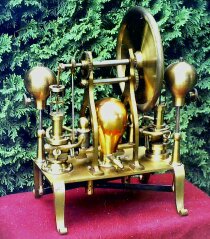
The press became interested, but Keely still could not be moved to give explanations. The well-reputed magazine Scientific American wrote about Keely's work with negative and partly derisive comments. The shareholders' interest considerably decreased after several delays when Keely still was unable to present a commercially usable machine. Fortunately, before he was doomed to go bankrupt, Keely could convince a rich widow, Mrs. Bloomfield-Moore to sponsor his continuing effort. However, he continued to fail.
An electrical engineer had the opportunity to see one of the machines which were claimed to be based on electrical priciples. In an unobserved moment, he grabbed an accidentially remaining piece of wire from the floor. The wire was found to be a fine pipe! This was new support for the suspicion that Keely powered his machines by compressed air delivered by a concealed compressor and pipework. After this came up, even Mrs. Bloomfield-Moore did no longer really trust in Keely and considerably reduced her payings.
After Keely's death, most machines were taken away by interested persons who may have hoped in eventually getting success out of Keely's preparational work. Mrs. Bloomfield-Moore's son, an engineer and a number of curious reporters investigated the inventors house and discovered conealed pipes in apparently massive columns and double floors. In the cellar they found a hollow concrete sphere of 3 tons weight; obviously a pressure reservoir. The reservoir was filled by a silent-running compressor driven by a water motor. Posthumously, Keely was uncovered as fraud who kept his business running for 26 years, without finishing or selling a single machine. The Encyclopaedia Britannica concludes the perpetual motion article: "In the course of his long career Keely may have broken a number of laws, but he left the first and second law of thermodynamics [...] inviolate." (Macropeadia vol.14, p.105 left col.)
Very interesting are the parallels to Bessler. Although unfair methods were uncovered, there still is a brave community of followers who think that the master knew about the secret of perpetual motion. The esoteric blabla of course is the ingenious prediction of today's modern atom theories!
In 1903 a certain William Strutt demonstrated a sensational simple "machine".
It was an electroscope which contained a small amount of radium. This William
Strutt (12.11.1842 - 30.7.1919) had to be taken serious, as he was not a
harebrained inventor, but a well-reputed physicist known as excellent researcher.
He won the Nobel prize 1904 and became the 3rd Lord Rayleigh due to his great
merits for the science.
The problem was: the apparatus worked.
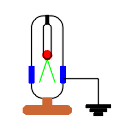
red: radium
green: thin metal sheets
blue: electrical ground connection
The vessel was made of quartz glass and evacuated in order to minimize the influence of air resistance and unintended electrical conduction. The radiation charged the leaves of the electroscope. As charged objects of the same polarity repel, the leaves spread until they touched the ground connection at the sides of the vessel. By this, they discharged and the whole process started again. When being observed over a longer period of time, no change in the frequency of the operation could be measured. Even the finest scales did not show any change in weight of the whole apparatus. Was this the long-searched perpetual motion device?
No. The tiny amount of energy which is needed to keep the electroscope running, could not cause a weighable loss of mass. This fact became clear with Einstein's famous formula E = mc2. The electroscope enigma was solved, when traces of helium were found in the quartz vessel. Helium atoms are recombined alpha particles which are generated by the fission of the highy radioactive radium. As alpha particles are electric posive, they caused the reaction of the electroscope.
However, a radium clock would run considerably longer than a thousand years, thus coming pretty close to the idea of the perpetual motion machine.
| ...next chapter |
Remarks:
1. Original German text: "Solche Projectemacher
wagen sich öfters an hohe Häupter, und hat ein Minister hierbey
alle Behutsamkeit anzuwenden, daß er erforsche ob sein Landes-Herr
mit einem ehrlichen Manne oder einem Betrüger zu tun habe..."
2. William Somerset's book has the full title:
A Century of the Names and Scantlings of such Inventions, As at
present I can call to mind to have tried and perfected, which (my former
notes being lost) I have, at the instance of a powerful friend, endeavoured
now in the Year 1655, to set these down in such a way as may suffieciently
instruct me to put any of them in practice. Printed by J. Grismond, London
1663. In chapter 56, Somerset describes his overbalanced wheel, without giving
an image. The first known image was a reconstruction given by Desaguliers
in 1720. The full text of the book is available in
Henry
Dircks's commented edition at the online library pages of the university
of Rochester
3. Original German text: "Ich weiß wohl, daß
Orffyreus verrückt, aber ich glaube nicht, daß er ein Betrüger
ist. Ich habe mich niemals dafür entschieden, ob seine Maschine ein
Betrug ist, aber eins weiß ich, wie nur irgend etwas in der Welt: wenn
die Dienstmagd das obige sagt, dann lügt sie."
4. The situation is unclear. According to different
sources, the clock was built by Jean and David Geiser in Neuchatel in
1815.
| Last update: 22 May 2004 / |
|